Unusual and Off-the-Beaten-Path Places to Visit in Sarajevo
Unlike many visitors to Sarajevo, we didn’t immediately fall for the capital of Bosnia and Herzegovina (BiH).
Looking back, we couldn’t tell you why because it’s a city that ticks a lot of boxes – Sarajevo is multicultural, with friendly people, it has a long and intriguing history, serves up good food and rocket-fuel-like coffee, and has an affordable cost of living. And not forgetting tasty burek at every turn! And, once you look beyond the old town, there are tonnes of alternative things to do in Sarajevo.
On reflection, it’s rare that a city finds itself on our list of favourite places after just one visit. It usually takes a couple of stays to start to get to know a place of any size and it almost certainly requires a bit of time spent beyond the main tourist sights.
A few years ago, we wrote about our initial impressions and suggestions of what to do in Sarajevo and finally, we have collated some of the more unusual places to visit in our guide to alternative Sarajevo.
Location map showing our favourite alternative things to do in Sarajevo
Alternative things to do in Sarajevo near the city centre
Taking the Baščaršija to be the central point within the city, there are a few places of interest to the west of this location that are all easily accessible on foot.
Sarajevo Railway Station
It’s worth stopping by the city’s train station if you are either a train geek or a fan of modernist architecture (or both!).
The station seen today was completed in the 1950s, but the original station, which no longer exists, and the line itself date back to 1872. The current building was a monumental project when it was first conceived in the late 1940s and the chief architects came from Czechoslovakia and East Germany. But, a period of political strain between Yugoslavia and the Soviet Union, which resulted in the Tito-Stalin split and Yugoslavia’s expulsion from the official central organisation of the International Communist Movement (Cominform) in 1948, halted the project for a number of years. It also meant that foreign (Eastern Bloc) architects could no longer be present in Yugoslavia and the station was eventually finished in 1953 by a group of Yugoslavian architects and engineers. These days, the building is a bit rundown and doesn’t see a lot of action, with the interior having a somewhat tumbleweed-city feel about it, but it is a fine example of socialist modern architecture.
The station was awarded National Monument of BiH status in April 2018.
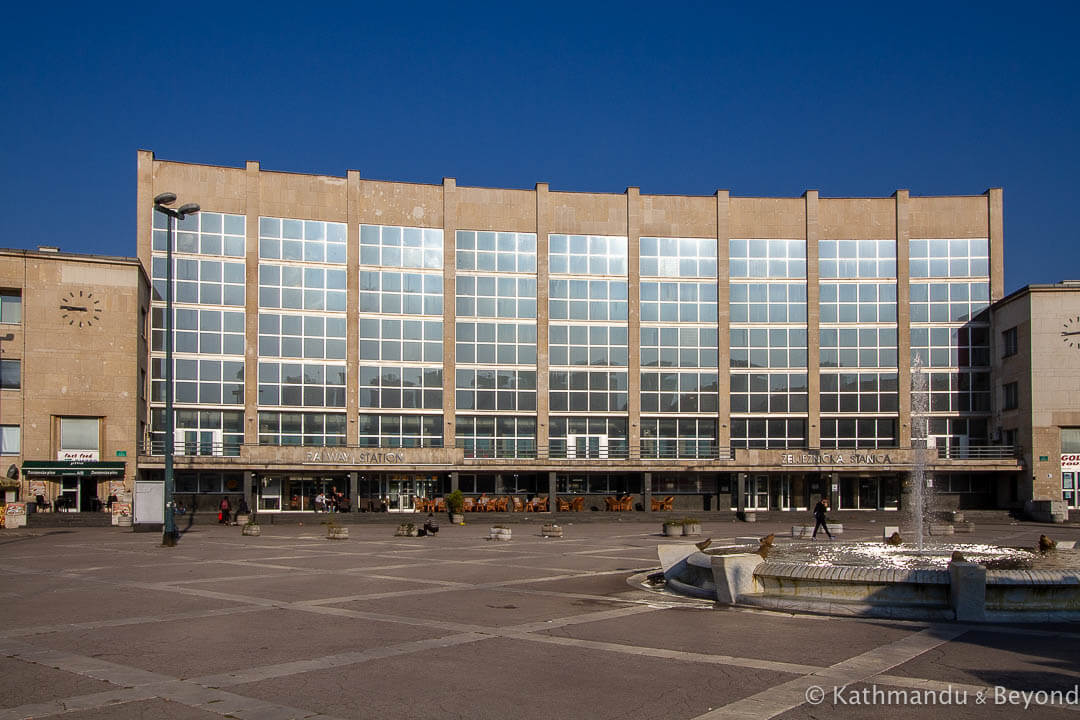
Sarajevo Railway Station
Skenderija
A multi-functional cultural, sports and trade centre, Skenderija, is the first of a handful of locations in Sarajevo associated with the 1984 Winter Olympics (officially, the XIV Olympic Winter Games), which the city hosted. The current complex, which was opened in 1969, is named after a 15th-century Ottoman governor called Skender Pasha who set up a trading centre, as well as the first Muslim tekke (monastery) in Bosnia, in this location in the late 1400s.
When Sarajevo discovered it was to host the Winter Olympics in 1977, the centre was greatly expanded to become a state-of-the-art ice-sports centre. Ice hockey matches and figure skating competitions were the main events held at Skenderija during the games and, for a few years thereafter, the location thrived as the city’s main centre for sports and culture.
But, the onslaught of the Siege of Sarajevo (part of the Bosnian War (April 1992-December 1995)), soon put a halt to all events and during the course of the conflict, the complex was badly damaged by hostile shelling. The building most affected by the destruction was the Dom Mladih (Youth House), which had previously built up a strong reputation as a springboard for up and coming pop and rock musicians and bands. There was a period after the war when Skenderija wasn’t used and it rapidly fell into a state of disrepair. It is in use again today and is still seen as an integral part of the city but there are sections of it that are still rather rundown and have an air of decay about them.
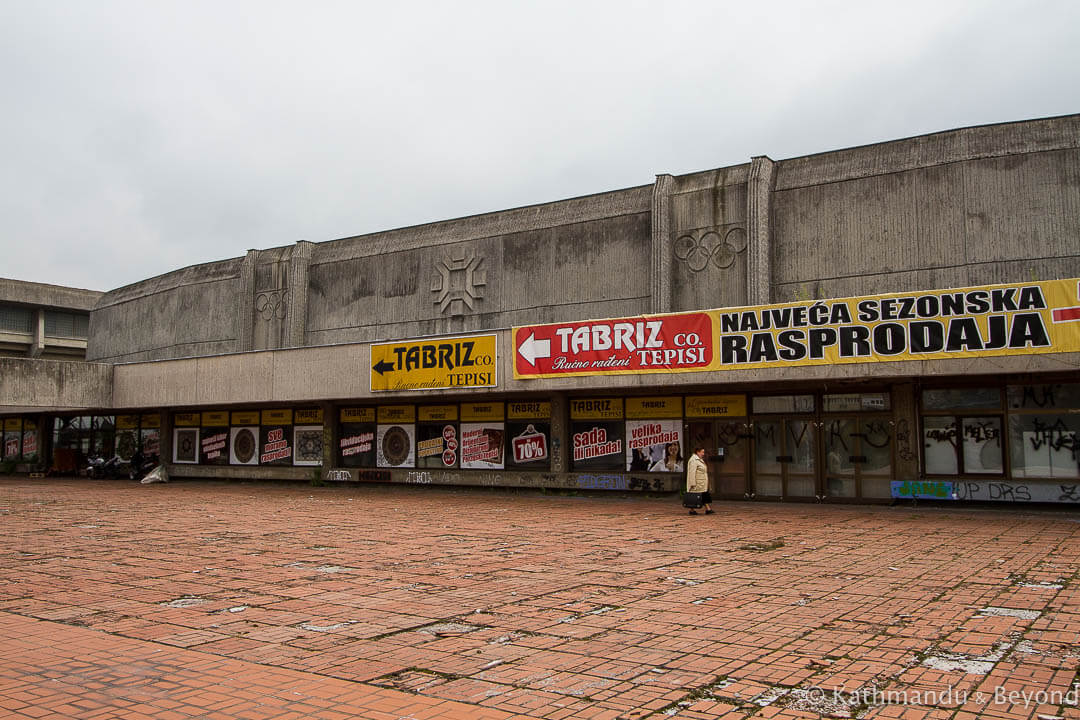
Skenderija
Monument to Đuro Đaković
You’ll find this monument, which is in the style of socialist realism, in the small park opposite the Skenderija. A metal worker by trade, Đuro Đaković was a Yugoslav revolutionary and activist who went on to become one of the founding members of the Communist Party of Yugoslavia in BiH. He was arrested and executed in 1929 for opposing the formation of a single Yugoslav nation, which was spearheaded by King Alexander I of the Kingdom of Serbia and existed for a short period between January 1929 and September 1931.
This monument to Đuro Đaković in Sarajevo was created in 1973 by Ljubomir Denković, a renowned Serbian sculptor whose other work includes two of the most impressive spomeniks (Tito-era Yugoslavia World War II-related monuments and memorials) we have seen to date – the Memorial Tomb to the Heroes of the Second World War in Veles (North Macedonia), which is still in decent condition, and the now-abandoned and isolated Monument to the Revolution in Grmeč (BiH).
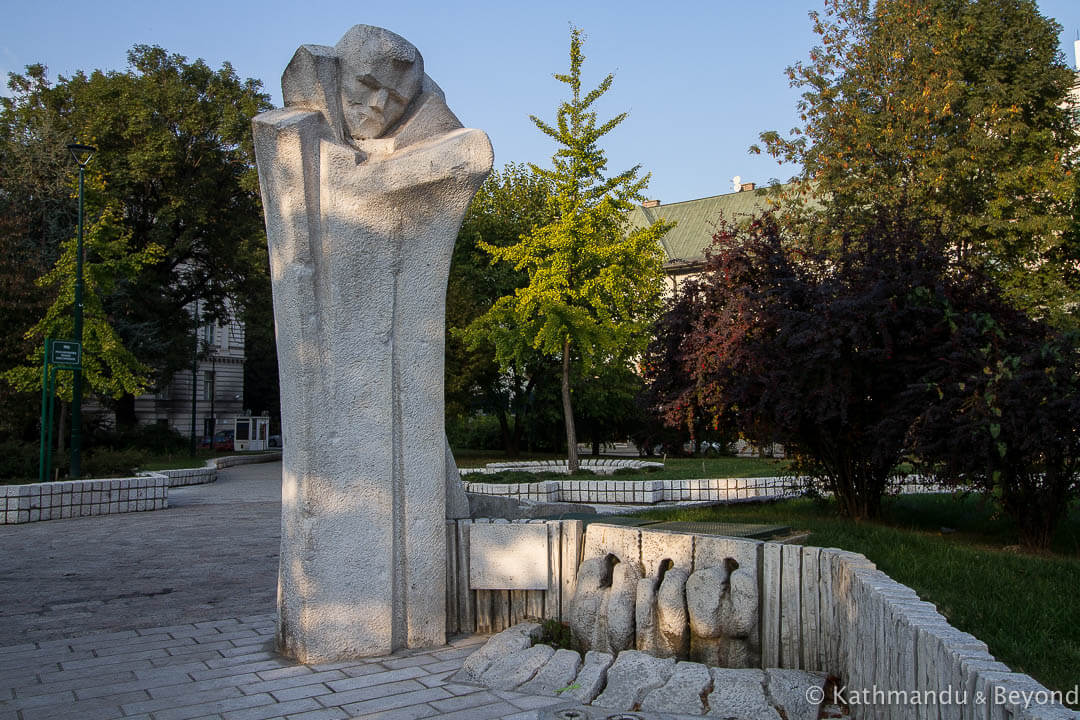
Monument to Đuro Đaković
Hotel Holiday (former Holiday Inn)
I talked about this hotel in our original post about Sarajevo, but it is such an important and distinctive landmark in the city that it deserves to be mentioned in this article as well.
Originally a Holiday Inn, the hotel was purpose-built for the 1984 Winter Olympics but it was its location on what soon became known as ‘Sniper Alley’ (in other words, the front line) during the Siege of Sarajevo that placed the building on the world stage. Used as a base by many international news bureaus during the war, and often sustaining damage due to regular shelling by Bosnian Serb forces, sometimes referred to as Chetniks (*), it became a global symbol of the blockade for many tuning in to follow the events, not least because of its highly recognisable mustard-coloured facade.
(*) The Chetniks were originally a Yugoslavian guerrilla detachment who fought against the Germans and their allies during World War II. With their ideology deeply rooted in Serb nationalism, the name was resurrected during the Yugoslav Wars. It is believed that in the region of 30,000 Chetniks served in Bosnia during the conflict, although the term became commonplace amongst pro-Serb opponents, who often tarnished all Serb units with the same brush.
Sarajevo’s Holiday Inn was famously described as “ground zero” by the Martin Bell, the BBC’s correspondent covering the siege, and who was severely wounded by shrapnel while filming a report in the city. This dated (2013) but nevertheless interesting article on the BBC includes several interesting stories about how the guests and staff alike managed to preserve an air of normality throughout what is officially the longest siege of a capital city in the history of modern warfare.
The hotel continued to operate after the war had ended attracting aid workers, predominantly, and some renovation work took place. The hotel lost its Holiday Inn branding in 2011 and closed for a period in 2015 before reopening at the Hotel Holiday (part of the Hotel Europe group) in 2016. In recognition of the hotel’s significant past, the new owners retained some original (Holiday Inn) branded features but the Holiday Inn’s parent group, InterContinental Hotels (IHG) put a stop to that which, in my opinion, was a shame and a bit mean spirited.
The property is fully functional as a hotel and its central location, which thrust it into the spotlight in the first instance, is second to none for exploring the city.
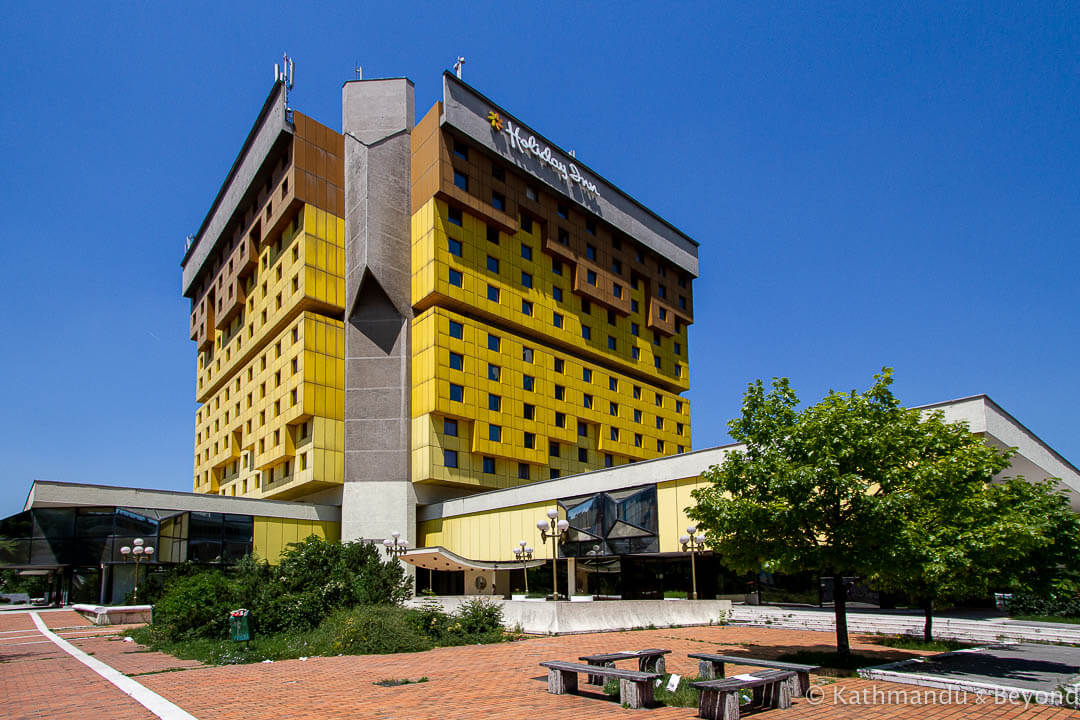
Hotel Holiday (former Holiday Inn)
Ciglane
Ciglane is a residential neighbourhood north of Sarajevo’s city centre. It is easily reached on foot and interesting not only because it presents the opportunity to a see a different side of the metropolis, away from the touristic hub of Stari Grad (Old Town), but also for its terraced housing estate that seemingly blends with the topography of the surrounding terrain. Called Naselje (settlement) Đuro Đaković, after the Yugoslav activist mentioned above, the estate was completed in 1989 on the site of an old brickyard that dates back to the early years of Austro-Hungarian rule in Bosnia.
From what I can work out, the micro-district was not especially damaged during the Bosnia War and what can be seen today is more or less the original concept. The only notable addition is the red building at the entrance to the estate. This is the district’s mosque and it was constructed between 2006 and 2012 on the site of what used to be a cinema.
The urban development sprawls over three levels that can either be reached via a set of crisscross stairs or a dinky funicular (when operational). The neighbourhood has a nice feel about it and there are a few outdoor cafes and restaurants as part of the estate’s parade of shops where you can grab a coffee, or whatever, and watch the world go by for a time.
There are a handful of cemeteries to the east of Ciglane where, doubtless, many of the victims of the Bosnian War are buried.
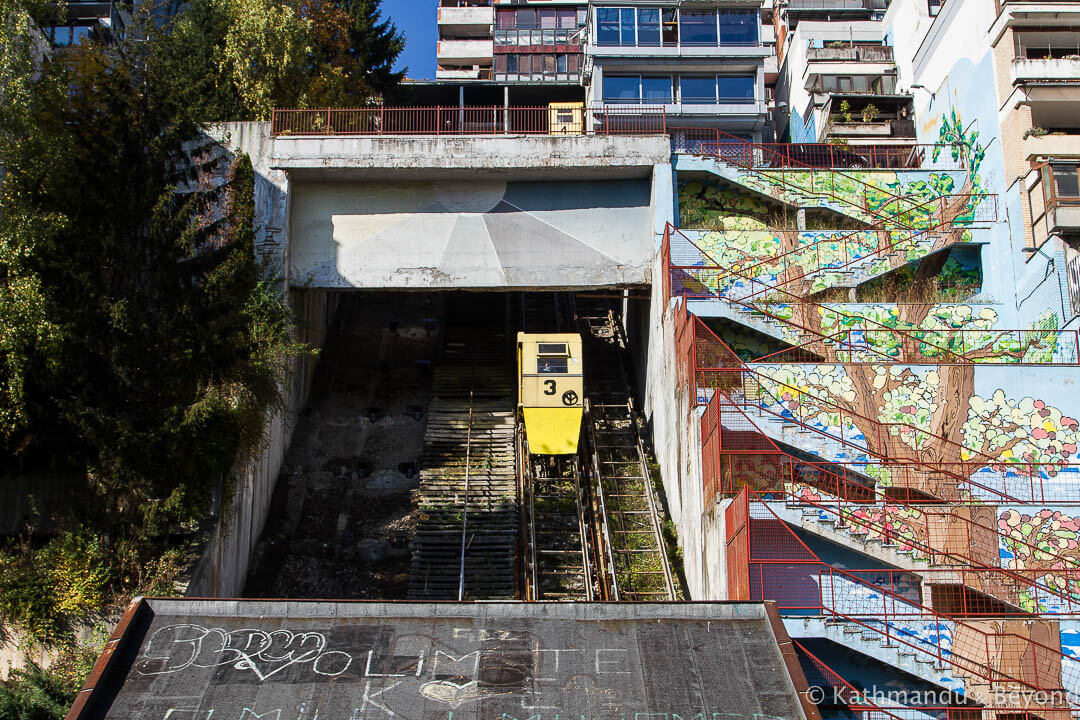
Ciglane
Asim Ferhatović Hase Olympic Stadium
More commonly known as Koševo City Stadium after the neighbourhood in which it is situated, this is another location associated with the 1984 Winter Olympics. The reason to come here is to see the large Olympic logo and rings standing tall at one end of the stadium and also the (now-faded) artwork depicting various winter sports and animated sgraffito of Vučko, the wolf who was the official mascot of the ’84 Games.
Koševo City Stadium is a 1km walk north of Ciglane.
Alternative things to do in Sarajevo west of the city centre
Heading in the direction of Sarajevo’s airport, the west of the city is dominated by large housing estates and other concrete-dominated buildings constructed during the country’s socialist period. The area is called Novi Grad (New Town) and I appreciate visiting it might not be everyone’s cup of tea. There is nothing else in the vicinity that we know of, so if urban centres do not interest you then I wouldn’t prioritise coming to this part of the city if your time is restricted. That said, Sarajevo Tunnel (Tunnel of Hope), which is situated on the other side of the airport, is not too far away and could be combined with what’s about to follow.
Alipašino Polje
Alipašino Polje is an urban neighbourhood at the heart of Novi Grad. It consists of three subsections (read housing estates) known as Faza A, Faza B and Faza C. The entire district, which translates as “Ali Pasha’s Field”, was constructed between 1974 and 1979. If you like photographing concrete skyscrapers then you will enjoy yourself in this part of Sarajevo, which happens to be the most densely populated part of the city.
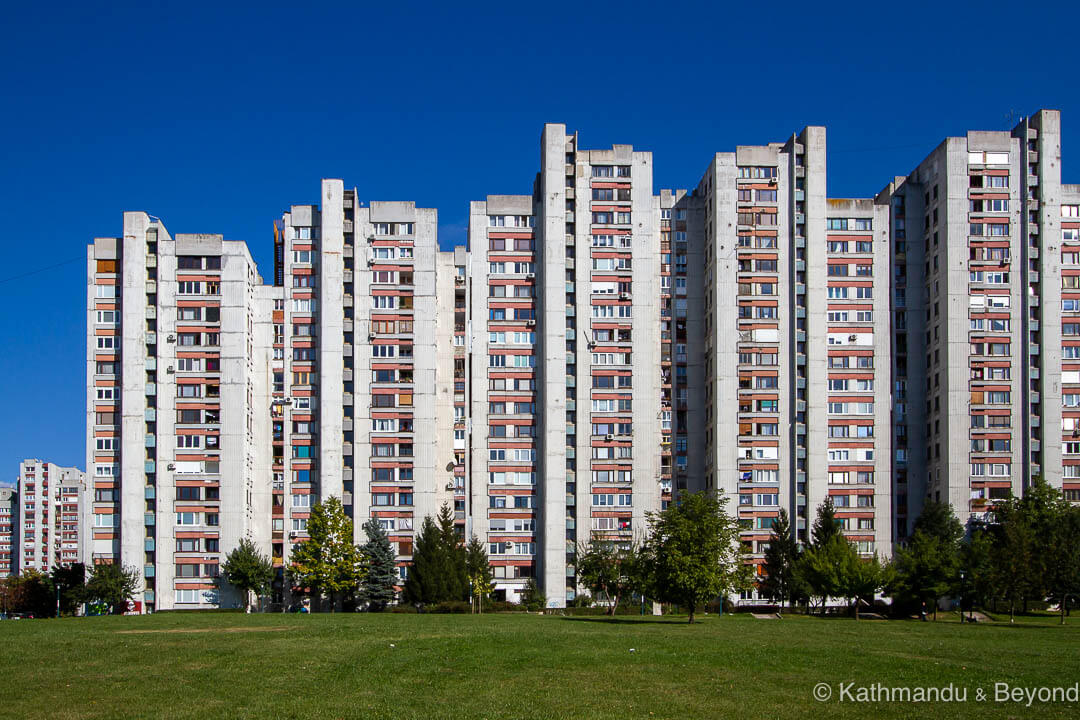
Alipašino Polje
St. Luke Evangelical Church
Very close to Alipašino Polje’s Faza C, this visually-striking church is a fantastic example of brutalist/modernist architecture. Work started on the parish church in 1998 but is not yet complete due to lack of funds. It is still used, however, and regular services are held there. The architect was Ivan Štraus, who was also responsible for the Museum of Aviation in Belgrade, Sarajevo’s UNITIC World Trade Towers and the Hotel Holiday (former Holiday Inn) mentioned above.
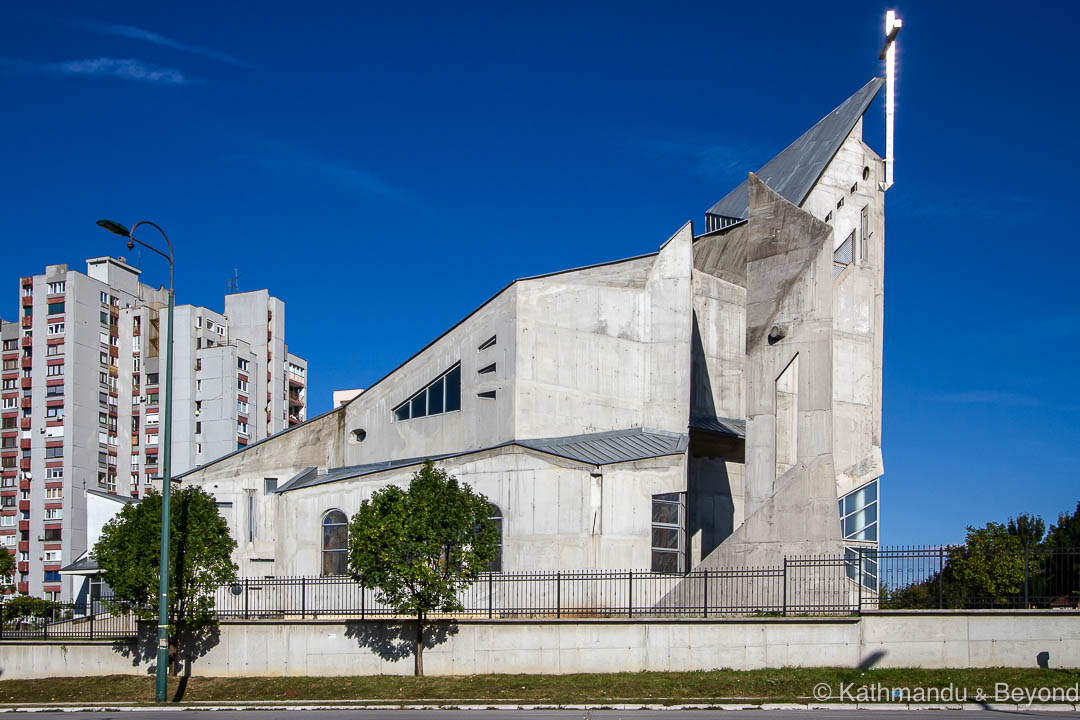
St. Luke Evangelical Church
Radio and Television of Bosnia and Herzegovina (BHRT) building
Another eye-catching monumental structure in this part of the city is the brutalist building of the Radio and Television of Bosnia and Herzegovina (BHRT), Bosnia’s state-level broadcaster. Nicknamed the ‘Grey House”, work started on it as early as 1975 but when the city discovered it had won the bid for the ’84 Olympics, the facility was modified to handle the up and coming event. Work on this meaty structure was finally completed in 1983.
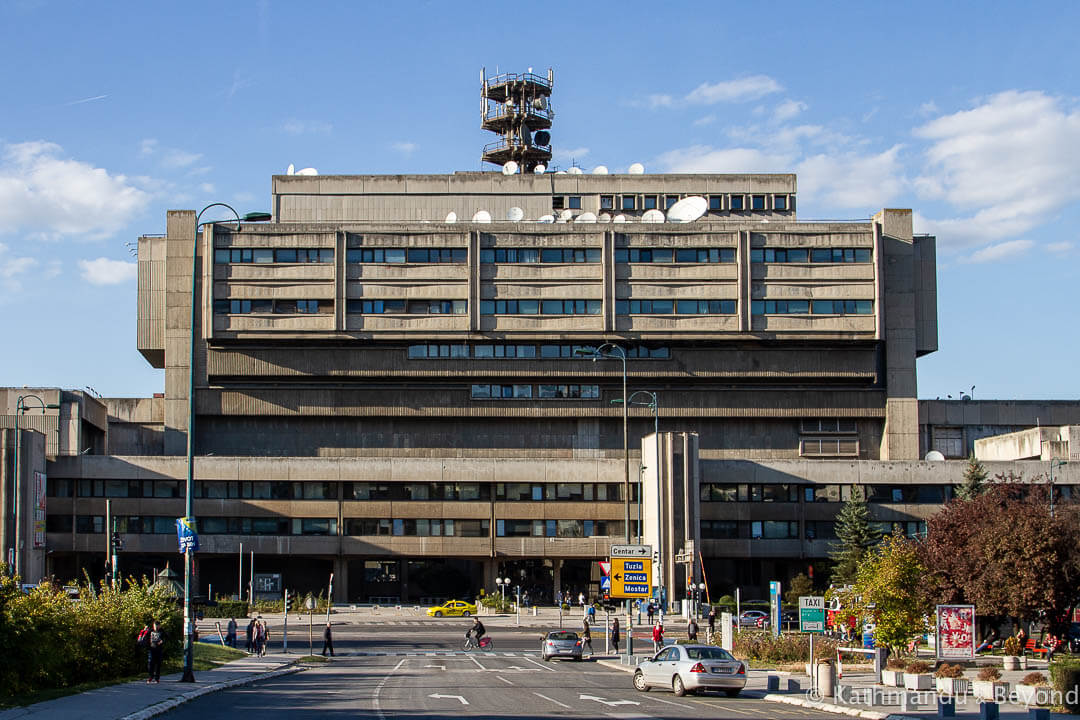
Radio and Television of Bosnia and Herzegovina (BHRT) building
Mojmilo Olympic Village
As its name would suggest, this housing complex, west of Alipašino Polje, in the suburb of Dobrinja was originally built to accommodate athletes, trainers, journalists and others involved with the 1984 Winter Olympics. The construction of the complex was completed in September 1983 and as well as accommodation, it included other facilities such as shops, a leisure centre and a large self-service restaurant. A number of sports facilities were also assembled nearby.
It was always intended that the village would become a residential district after the Olympic participants had left, although the units were generally occupied by better-off Sarajevans and overseas students. I believe the rationale behind this was that because the accommodation was built for the Olympics, it was of a higher standard than some of the other housing in the city at the time and that is why those with connections and\or money were able to move in.
Dobrinja was the most bombed neighbourhood in the city during the Siege of Sarajevo and most of it, including the former Olympic village, was badly damaged as a result. In the mid-1990s, it was rebuilt with the assistance of foreign money. The major benefactor was the municipal government of Barcelona and a memorial commemorating this can be seen near the pedestrianised part of the estate.
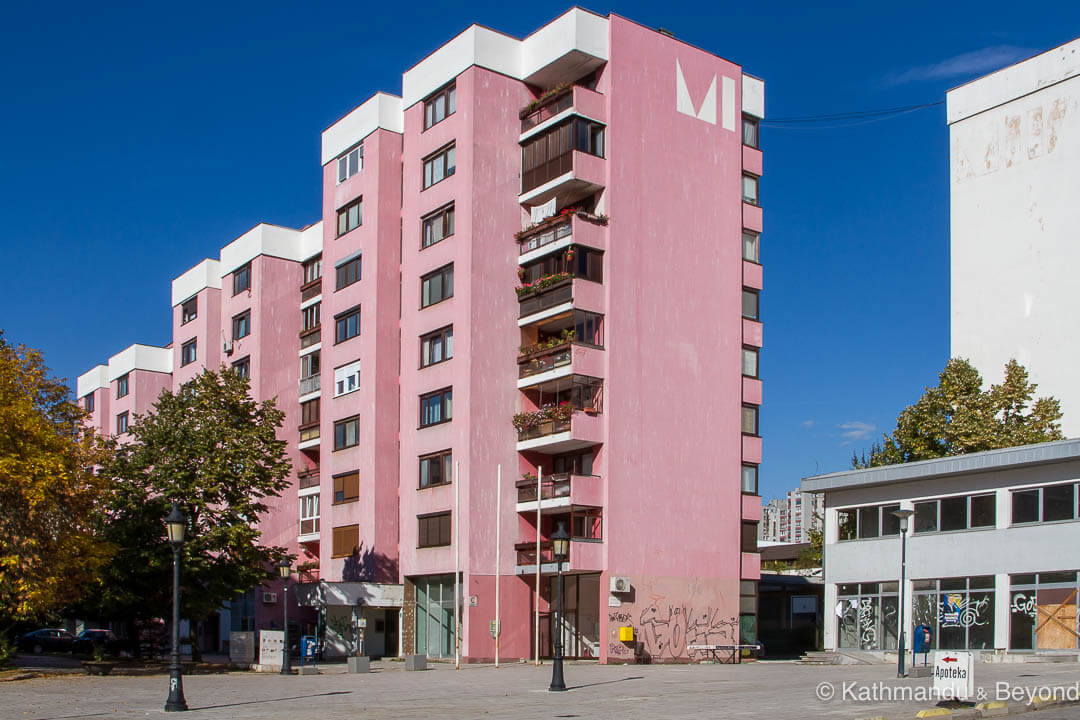
Mojmilo Olympic
How to get to Mojmilo Olympic Village by public transport
It’s easy to get to Dobrinja suburb by bus or tram. There are several options but the most useful ones are: Bus #103 from Trg Austrije (south of the river, close to Latin Bridge) or bus #5a from Vijećnica terminal behind Sarajevo City Hall.
Another option is to take tram number 3 or 5 from the Baščaršija stop in the old town. Alight at Alipašino polje stop from where it is about a 10-minute walk.
Alternative things to do in Sarajevo – Mount Trebević
Mount Trebević is the large forested mountain that dominates the southeast of Sarajevo. Most visitors head up it for the panoramic vistas back across the city but there are a handful of less-visited locations at various points along its slopes that are also worth searching out, particularly if you are a tombstone tourist or enjoy a spot of (gentle) urbexing.
Old Jewish Cemetery
Dating back to the 17th century and the time of the Ottoman Empire, this Sarajevo graveyard is one of the largest Jewish cemeteries in South-East Europe. It only ceased being used as a cemetery in 1966 and is crammed with weathered tombstones of various shapes and sizes. This ancient burial ground is an interesting and peaceful place to wander around for an hour or so and worth the uphill trudge to reach. The cemetery is located on the lower slopes of Mount Trebević and so, depending on the time of year and the number of leaves on the trees, there is also a good view back down on to the centre of Sarajevo.
And don’t be surprised if you notice bullet holes on some of the graves while wandering around. The cemetery was used as an artillery position by Bosnian Serbs during the Bosnian War and was also heavily mined during the conflict.
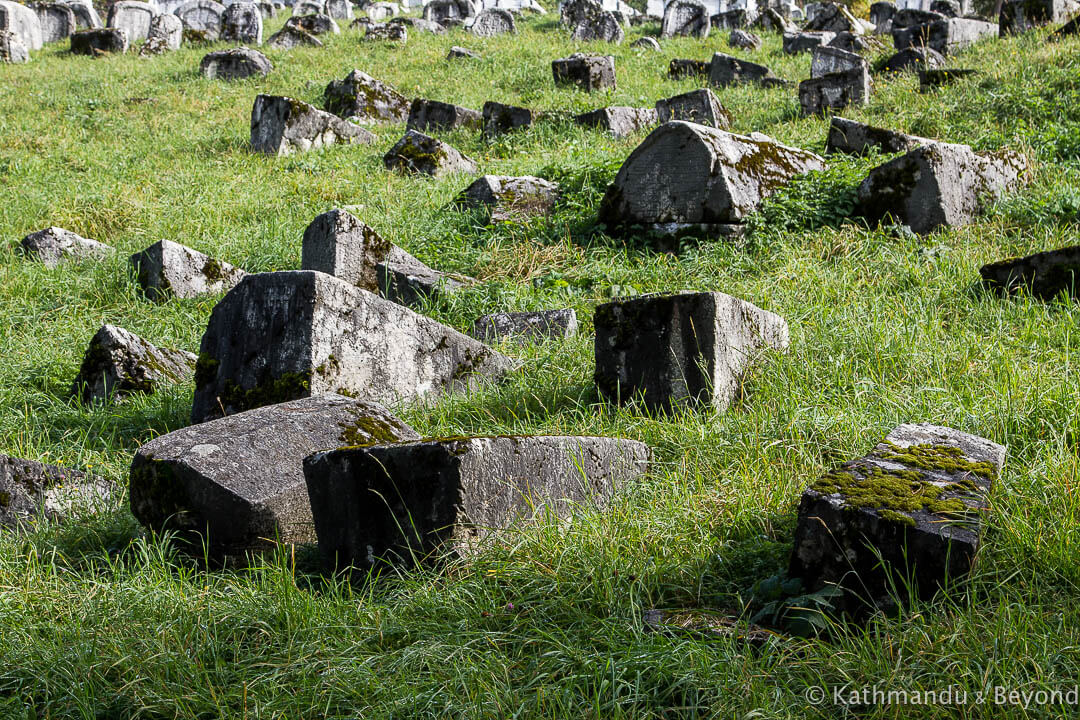
Old Jewish Cemetery
Vraca Memorial Park
Occupying the site of an old Austro-Hungarian fortification, Vraca Memorial Park is a Spomenik Park, approximately 1.3km southwest of the Old Jewish Cemetery. It is dedicated to the thousands of Sarajevans, both partisans and civilians, who were killed during World War II. Many of the victims were butchered at the actual location because the occupying Axis forces turned the fortress into a prison camp and execution site during the war.
The present-day memorial park was opened during the Yugoslav era on 25th November 1981 (Bosnia’s ‘Day of Statehood’), and although it holds great cultural and historical significance within the city, and is seen a symbol of antifascism, sadly the location and its monuments are neglected and, in some instances, part-damaged or vandalised. Although much of the park’s damage can be attributed to the systemic destruction unleashed by retreating Bosnian Serb forces who had previously used the territory as a tactical position during the Siege of Sarajevo, evidence of present-day rehabilitation of the site wasn’t particularly noticeable when we visited in the autumn of 2018. Most of the monuments had been graffitied, the Eternal Flame was overgrown and the Monument to Women Fighters and Victims, which is a little to the east of the main ensemble, is missing an arm.
It is a pity to see a place like this in such a sorry condition but if you are interested in Yugoslavia-era spomeniks then this one is easy to visit without your own transport, which is certainly not always the case.
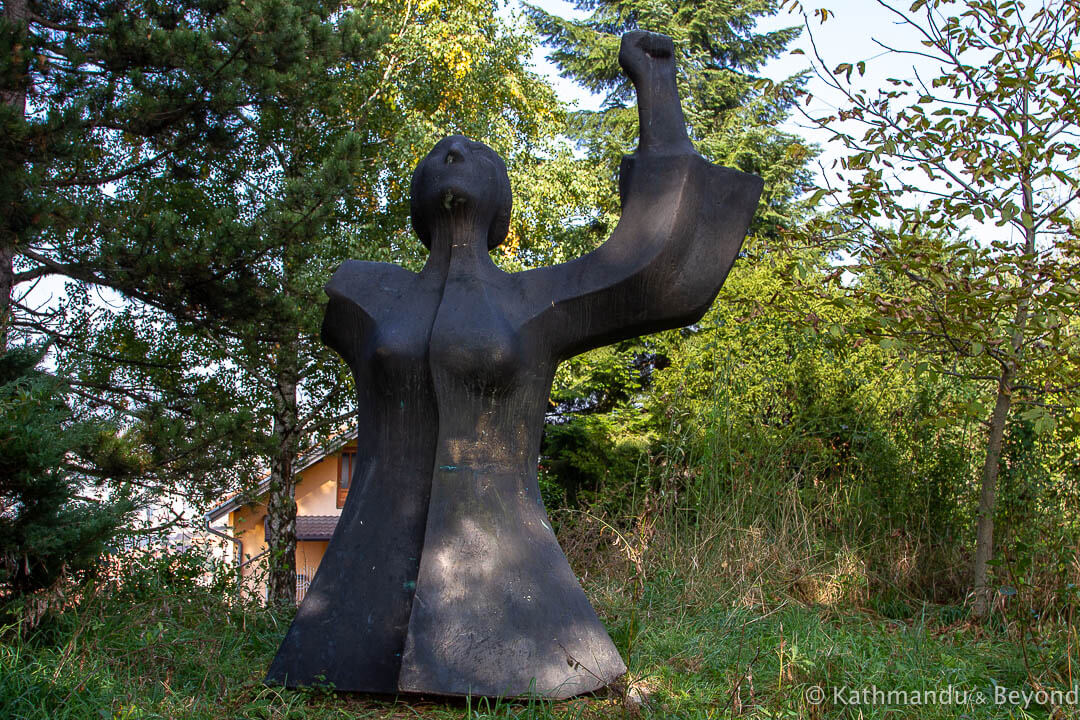
Monument to Women Fighters and Victims, part of Vraca Memorial Park
Abandoned house featuring Mr Chat street art
Considerably further up Mount Trebević are the shells of two war-torn houses, one of which features a large mural of Mr Chat, the well-known (at least in street art circles) grinning cat that makes Kirsty jump up and down with joy every time she sees one. Update June 2025: As per the comment below, Mr Chat has been painted over. The building is still there.
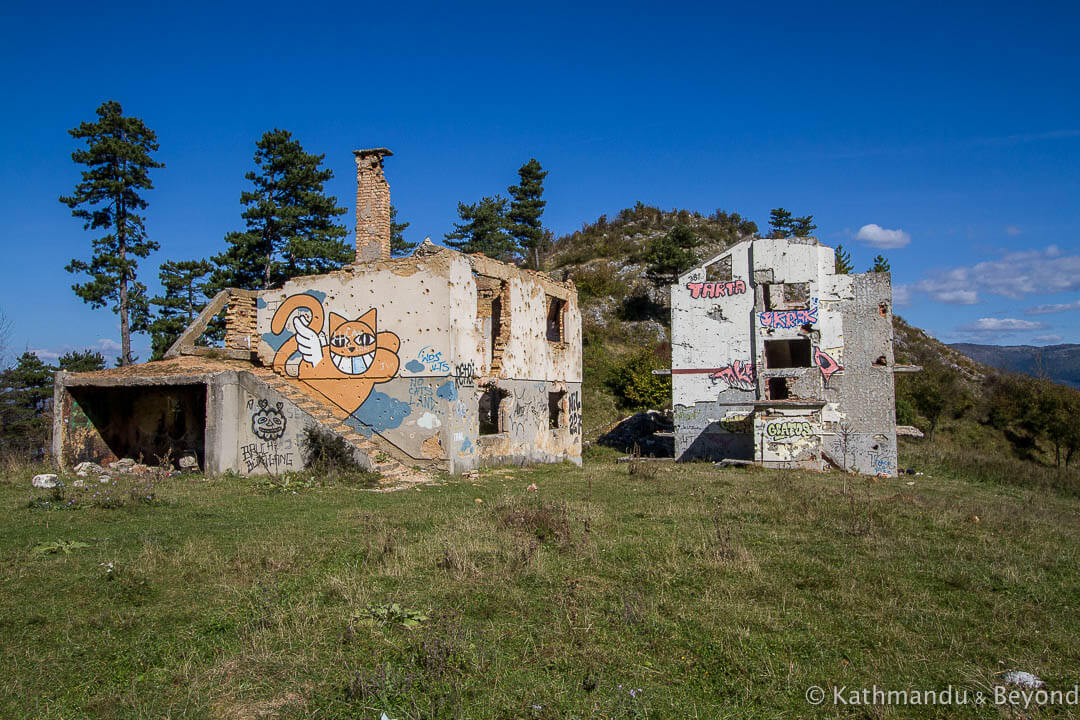
The abandoned house featuring Mr Chat street art
Čolina Kapa Astronomical Observatory
A short distance from the abandoned houses are the ruins of Čolina Kapa Astronomical Observatory. Because of the uninterrupted view of the city, the original use of the location was as a fortification for the Austro-Hungarian military but several years after World War II, in 1967, the site was given over to the University Astronomical Society and converted into an astronomical observatory. Like many structures in and around Sarajevo, it was destroyed during the Bosnian War and has remained abandoned ever since.
Also known as the Bistrik Tower, there are currently no restrictions on exploring the structures.
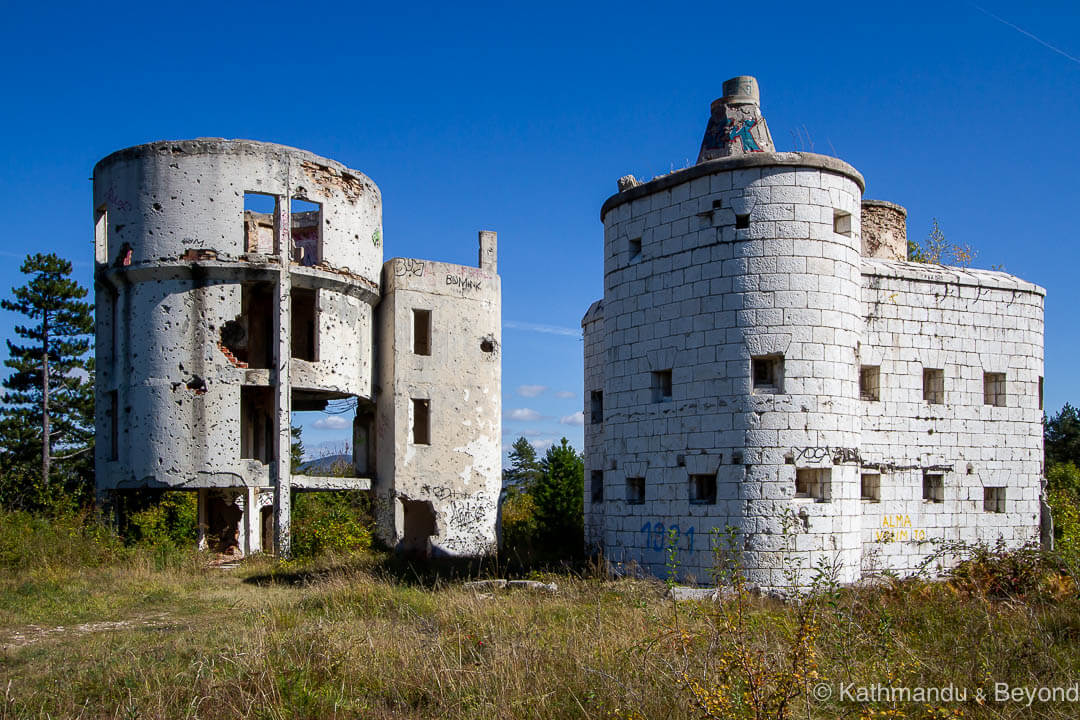
Čolina Kapa Astronomical Observatory
Sarajevo Olympic Bobsleigh and Luge Track
Of all the reminders of the 1984 Winter Olympics, the concrete remnants of the bobsleigh and luge track on Mount Trebević are unquestionably the most well-known, and also the most visited. The track complex was completed at the end of September 1982 and was first used for international competition in January the following year. The tracks attracted thousands of spectators during the games and continued to be used for world events until the beginning of the Yugoslav Wars in 1991.
Looking beyond the continuous graffiti, it would seem, at first glance, that the concrete tracks are in relatively decent condition. But, look closer and you’ll see the scars of war, including bullet holes, mortar damage and also the remains of makeshift bunkers nearby. Enthusiastic crowds that once gathered here to watch this exhilarating sport were replaced with well-armed Bosnian Serb forces, many of them self-proclaimed Chetniks, who used the twisting tracks and surrounding jungle-like forest as defensive positions throughout the Siege of Sarajevo.
Nowadays, and especially since the re-opening of the cable car (see below), Sarajevo’s Olympic bobsleigh track has become quite the tourist attraction. Independent travellers, groups and even families heading off for a walk after admiring the view, all come and have a poke around this sporting relic. And when they get the chance, the skateboarders, rollerbladers and graffiti street artists take over to do their thing. Still, unless you’re an urbexing snob who can’t abide having your ruins infiltrated by others, it remains a fascinating place to explore for a time.
Before moving on, it is highly likely that there are still unexploded artillery shells in the woodlands that surround the course so venturing away from well-defined paths is not recommended.
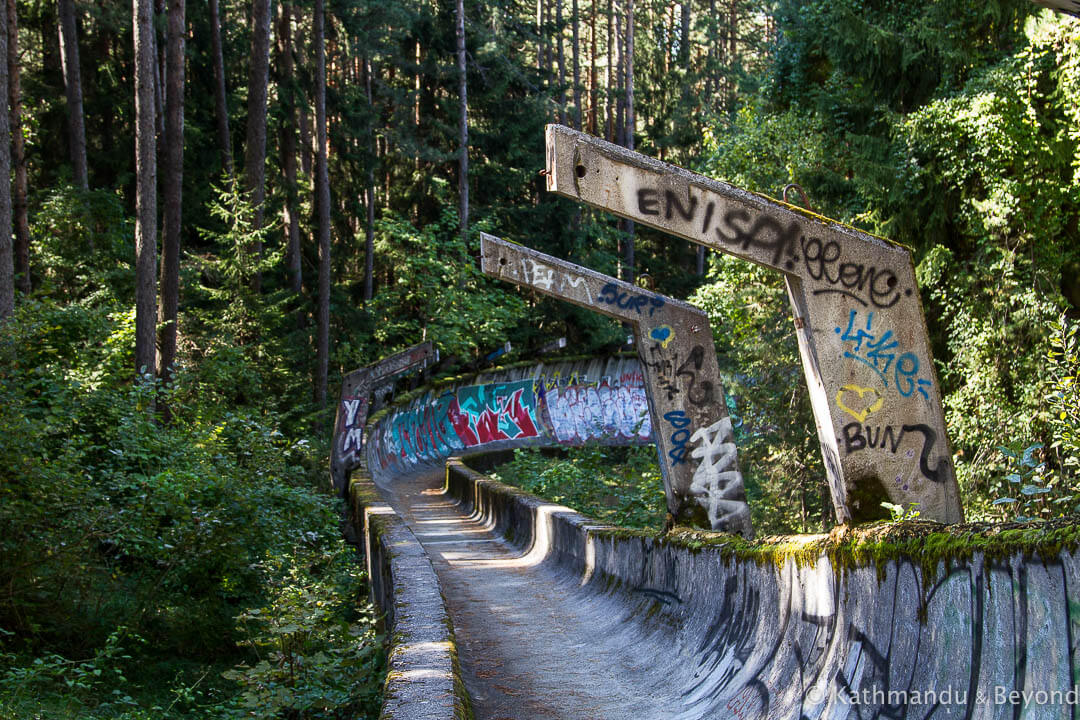
Sarajevo Olympic Bobsleigh and Luge Track
Getting to Sarajevo Olympic Bobsleigh and Luge Track, Čolina Kapa Astronomical Observatory and the abandoned house featuring Mr Chat street art
Private transport aside, there are two options for accessing the three places of interest higher up Mount Trebević. The first of these is to take the Sarajevo cable car, which resumed operations again in 2018 after being destroyed during the course of the Bosnian War. At 15 KM (€7.60) for a one-way adult ticket and 20 KM (€10.20) for a return one for tourists (*), it isn’t the cheapest option but it is certainly the most convenient as it effortlessly transports you from the Old Town up to the top of the mountain and back as well as providing some stupendous views along the way.
(*) Bosnians pay 4KM (one way) and 6 KM (return).
If you decide to take the cable car both ways then you will need to walk down part of the mountain to see the three places mentioned above and then back up again to rejoin the cable car.
The alternative way to get up and down Mount Trebević is to walk. It’s a relatively tough hike in parts, especially if the ground is wet and slippery, but it is certainly doable as long as you are wearing decent footwear. To undertake the hike, you first need to make your way to the edge of the small neighbourhood of Boguševac (exact GPS marked on the map), where you will see a small path leading into the woods. This is the route you need to take. As the crow flies, it’s only about 600 metres to the abandoned houses but the distance is more like 1.2kms as the path snakes its way up the hill. From the abandoned houses, the onward route to the observatory and the bobsleigh track is easy to navigate.
Taking this course means you will end up at the bottom of the bobsleigh track, from where you can walk the length of the tube itself as a means of making your way up to the beginning of it.
Even though it expends a lot more energy, if you are planning to take the cable car one way and walk the other, I would personally hike up and take the cable car back down. Why? Because the path leading up from Boguševac is steep and, unless you’ve got knees made of armoured plates, it is going to be agony for practically all the time you are coming down. Also, if the path is slippery then descending it is going to be a lot trickier than going up.
IF YOU FOUND OUR GUIDE TO ALTERNATIVE THINGS TO DO IN SARAJEVO HELPFUL, PLEASE SHARE IT…
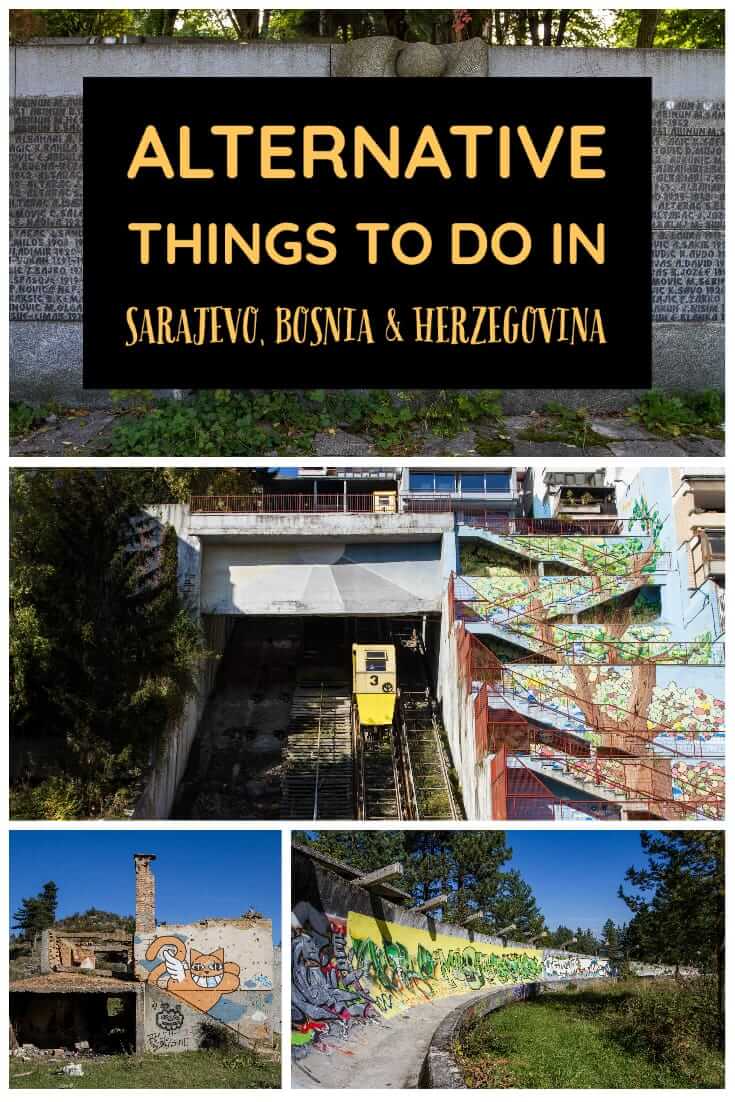
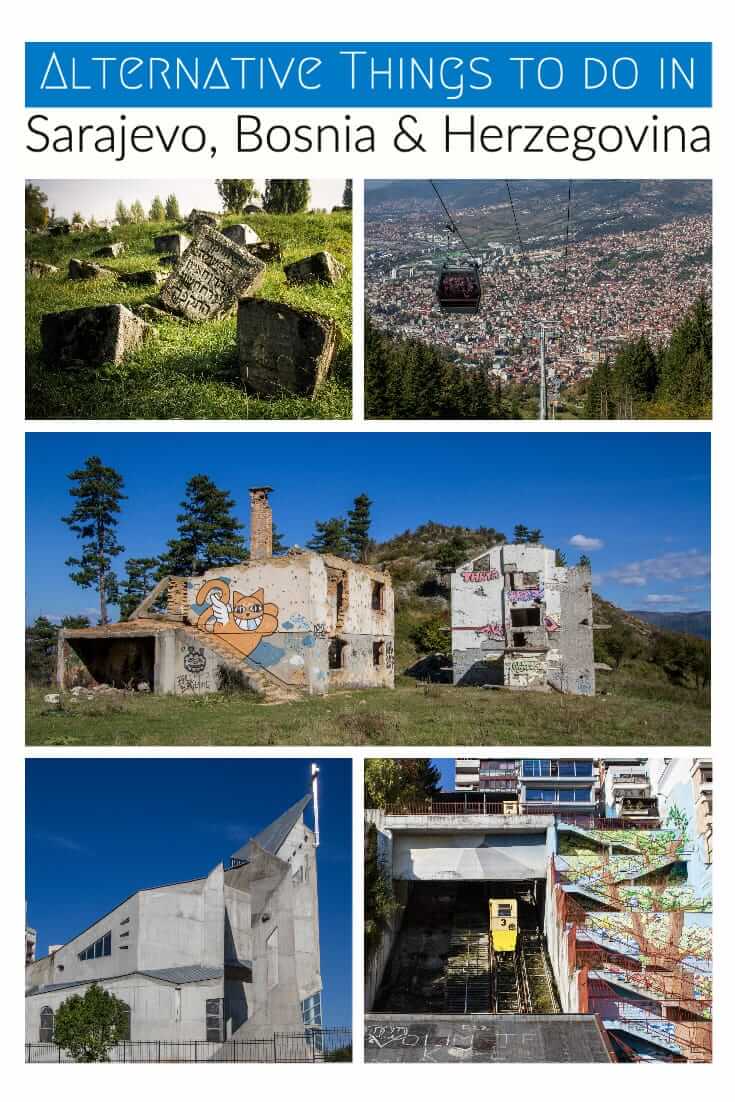
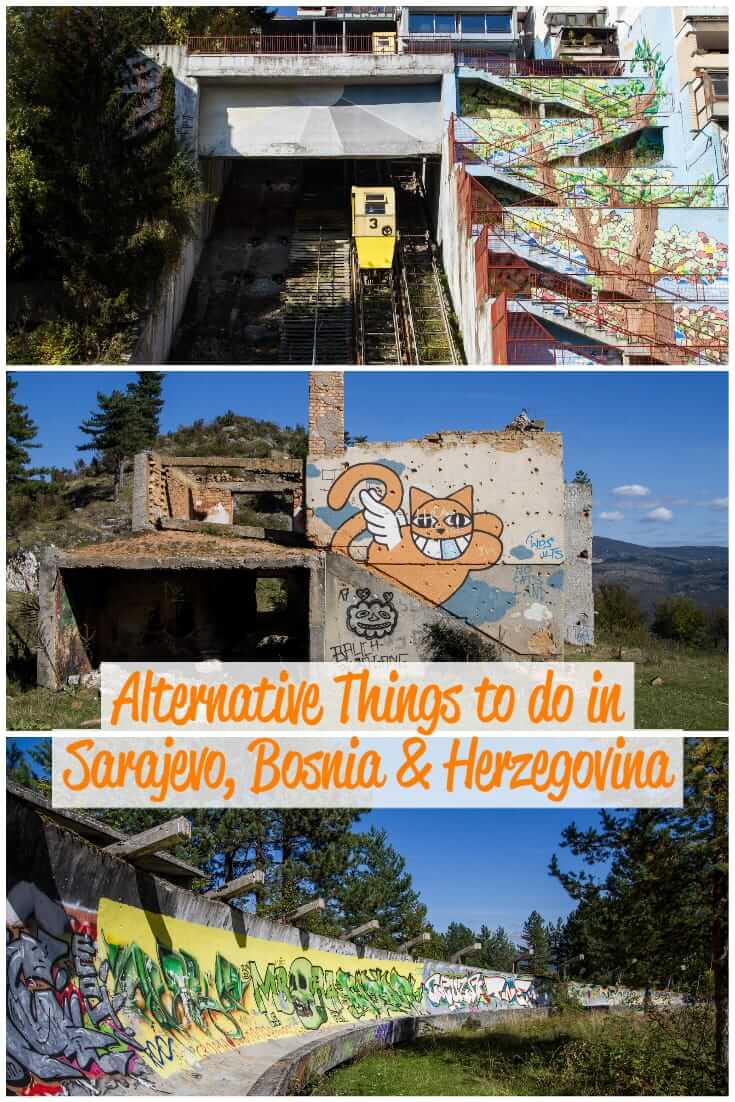
READ MORE BLOG POSTS ABOUT THE BALKAN COUNTRIES

Unfortunately Mr Chat has been painted over. Was there last week (middle of June 2025)…
Thanks for the update. We will add a note to the post.